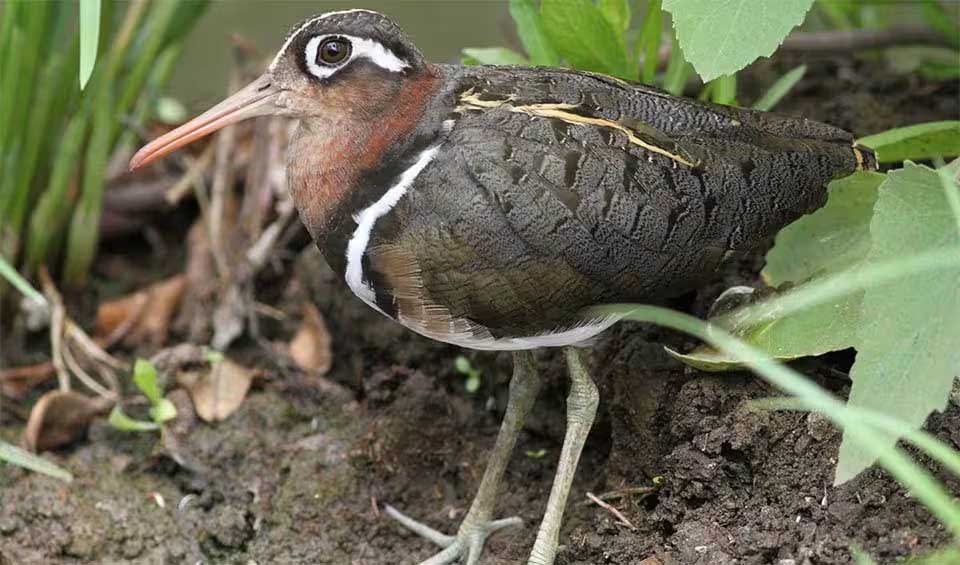The Greater Painted-Snipe is a fascinating and distinctive wading bird species that captures the attention of birdwatchers and wildlife enthusiasts with its unique characteristics and behaviors. With its chubby appearance and striking plumage, this bird stands out as a charismatic inhabitant of tropical and subtropical wetlands across its range.
One of the most intriguing aspects of the Greater Painted-Snipe is its fascinating breeding biology, which exhibits a remarkable reversal of typical avian gender roles. During the mating season, it is the female that displays brighter and more colorful plumage compared to the male, a phenomenon known as sexual dichromatism. This reversal of plumage brightness challenges traditional notions of avian sexual dimorphism and adds an interesting dimension to the species’ reproductive biology.
In terms of distribution, the Greater Painted-Snipe occupies a diverse range of wetland habitats, from the lowlands to elevations of up to 1.8 kilometers (5905 feet) in the Himalayas. While they can adapt to a variety of wetland environments, they tend to avoid dry areas and instead prefer sites that have recently flooded. This habitat preference underscores the species’ reliance on wetland ecosystems for foraging and breeding.
Speaking of foraging, the diet of the Greater Painted-Snipe is as diverse as its habitat preferences. These birds are opportunistic feeders, preying on a variety of invertebrates such as insects, snails, earthworms, and crustaceans. Additionally, they have been observed consuming plant materials like seeds, grains, and millet, demonstrating their ability to adapt their diet based on seasonal availability and resource abundance.
Distribution
 Afghanistan
Afghanistan Angola
Angola Bangladesh
Bangladesh Benin
Benin Botswana
Botswana Brunei
Brunei Burkina Faso
Burkina Faso Burundi
Burundi Cambodia
Cambodia Cameroon
Cameroon Central Af. Rep.
Central Af. Rep. Chad
Chad China
China Congo-Brazzaville
Congo-Brazzaville Côte D’ivoire
Côte D’ivoire East Timor
East Timor Egypt
Egypt Equatorial Guinea
Equatorial Guinea Eritrea
Eritrea Eswatini
Eswatini Ethiopia
Ethiopia Gabon
Gabon Gambia
Gambia Ghana
Ghana Guinea-Bissau
Guinea-Bissau Guinea
Guinea Hong Kong
Hong Kong India
India Indonesia
Indonesia Iran
Iran Iraq
Iraq Israel
Israel Japan
Japan Jordan
Jordan Kenya
Kenya Korea
Korea Laos
Laos Lesotho
Lesotho Liberia
Liberia Madagascar
Madagascar Malawi
Malawi Malaysia
Malaysia Mali
Mali Mauritania
Mauritania Mozambique
Mozambique Myanmar
Myanmar Namibia
Namibia Nepal
Nepal Niger
Niger Nigeria
Nigeria Oman
Oman Pakistan
Pakistan Philippines
Philippines Rwanda
Rwanda Senegal
Senegal Sierra Leone
Sierra Leone Singapore
Singapore Somalia
Somalia South Africa
South Africa South Sudan
South Sudan Sri Lanka
Sri Lanka Sudan
Sudan Taiwan
Taiwan Tanzania
Tanzania Thailand
Thailand Togo
Togo Uganda
Uganda Vietnam
Vietnam Yemen
Yemen Zambia
Zambia Zimbabwe
ZimbabweAnything we've missed?
Help us improve this page by suggesting edits. Glory never dies!
Suggest an editGet to know me
Terrestrial / Aquatic
Altricial / Precocial
Polygamous / Monogamous
Dimorphic (size) / Monomorphic
Active: Diurnal / Nocturnal
Social behavior: Solitary / Pack / Herd
Diet: Carnivore / Herbivore / Omnivore / Piscivorous / Insectivore
Migratory: Yes / No
Domesticated: Yes / No
Dangerous: Yes / No




